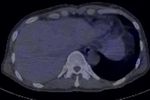Transarterial Radioembolization as an Effective Local Treatment Modality for Liver Metastasis of Thyroid Cancer
←
→
Page content transcription
If your browser does not render page correctly, please read the page content below
Endocrinol Metab 2022;37:383-385
Letter https://doi.org/10.3803/EnM.2022.1437
pISSN 2093-596X · eISSN 2093-5978
Transarterial Radioembolization as an Effective Local
Treatment Modality for Liver Metastasis of Thyroid Cancer
Yoo Hyung Kim1, Hyo-Cheol Kim2, Yun Bin Lee1,3, Samina Park4, Eun-Jae Chung5, Jin Chul Paeng6,
Young Joo Park1,7
Departments of 1Internal Medicine, 2Radiology, 3Department of Internal Medicine and Liver Research Institute, Departments of
4
Thoracic and Cardiovascular Surgery, 5Otolaryngology-Head and Neck Surgery, 6Nuclear Medicine, Seoul National University
Hospital, Seoul National University College of Medicine; 7Department of Molecular Medicine and Biopharmaceutical Sciences,
Graduate School of Convergence Science and Technology, Seoul National University, Seoul, Korea
Transarterial radioembolization (TARE) has recently emerged tron emission tomography (PET)/CT (Fig. 1A, B).
as a new therapeutic option for patients with hepatocellular car- Total thyroidectomy and neck dissection, innominate vein re-
cinoma. Microspheres impregnated with the radioisotope yttri- section and reconstruction, en bloc resection of the sternum, and
um-90 (90Y) are selectively delivered through the hepatic artery, wedge resection of the lung were performed. Pathologic diag-
which feeds the tumor. 90Y, a β-emitting isotope with a short nosis concluded that the tumor was a PDCA originating from
half-life (2.67 days), exerts powerful anti-cancer effects, with the tall cell variant of papillary thyroid cancer. BRAFV600E and
the emitted β particles having mean and maximum tissue pene- TERTC228T mutations were identified. Planning angiography and
tration depths of 2.5 and 10 mm, respectively [1]. Here, we re- a lung shunt scan showed minimal vascularity of the liver me-
port a patient who presented with poorly differentiated thyroid tastases (Fig. 1C) and negligible extrahepatic activity, respec-
cancer (PDCA) with lung, liver, and bone metastases and was tively.
successfully treated with TARE for liver metastases. For hepatic metastasis, loco-regional treatments such as surgi-
A 55-year-old man was referred for a huge neck mass and cal resection, radiofrequency ablation therapy (RFA), transarte-
was suspected of having metastatic thyroid cancer. The primary rial chemoembolization (TACE), or external radiation therapy
thyroid mass in the right lobe invaded the trachea, and very (EBRT) and/or systemic 131I therapy are traditionally considered
large ipsilateral metastatic lymph nodes encased the right com- [2]. However, the applications of loco-regional treatment op-
mon carotid artery. A bone-destructive mass in the anterior me- tions to large masses with weak arterial-phase hyperenhance-
diastinum extended to the upper mediastinum and compressed ment (APHE) are limited. In this particular case, surgical treat-
the left innominate vein. Other hypermetabolic masses were ment was not suitable because of the patient’s previous major
found in the right acetabulum, both lungs, and the left lobe of surgery. The tumor (5.2 cm) was too large to be treated by RFA.
the liver. The liver masses showed heterogeneous enhancement 131
I was expected to be relatively ineffective as the tumor was
on arterial-phase dynamic computed tomography (CT) and in- PDCA and showed high FDG uptake. TACE was also not suit-
tense hypermetabolism on 18F-fluorodeoxyglucose (FDG) posi- able because of weak APHE. We thoroughly discussed the pos-
Received: 17 February 2022, Revised: 16 March 2022, Copyright © 2022 Korean Endocrine Society
Accepted: 17 March 2022 This is an Open Access article distributed under the terms of the Creative Com
Corresponding author: Young Joo Park mons Attribution Non-Commercial License (https://creativecommons.org/
Department of Internal Medicine, Seoul National University Hospital, Seoul licenses/by-nc/4.0/) which permits unrestricted non-commercial use, distribu
National University College of Medicine, 101 Daehak-ro, Jongno-gu, Seoul tion, and reproduction in any medium, provided the original work is properly
03080, Korea cited.
Tel: +82-2-2072-4183, Fax: +82-2-764-2199, E-mail: yjparkmd@snu.ac.kr
www.e-enm.org 383Figure1
Kim YH, et al.
C
B
D B C
Tg 1220.8 ng/mL (TSH 3.75 uIU/mL)
AST/ALT/ALP 10/9/83 IU/L
A B
D
Tg 357.5 ng/mL (TSH 19.73 uIU/mL)
AST/ALT/ALP 13/19/76 IU/L
C D 150 mCi 3 days A E
Tg 20.33 ng/mL (TSHTARE for Liver Metastasis of Thyroid Cancer
size was reduced to 15 cm. The metastatic mass, which had REFERENCES
changed to become dense and fibrotic, could be surgically re-
moved [5]. Likewise, TARE was successfully applied for a 1. Salem R, Lewandowski RJ, Sato KT, Atassi B, Ryu RK,
large, hypervascular metastatic mass in the liver from thyroid Ibrahim S, et al. Technical aspects of radioembolization with
cancer as a bridging therapy to surgical resection. Both in this 90Y microspheres. Tech Vasc Interv Radiol 2007;10:12-29.
case and our case, the expected effects were not influenced by 2. Haugen BR, Alexander EK, Bible KC, Doherty GM, Mandel
the tumor differentiation status, which is the main limitation of SJ, Nikiforov YE, et al. 2015 American Thyroid Association
131
I therapy. Therefore, TARE could be considered alternatively management guidelines for adult patients with thyroid nod-
as an effective locoregional treatment option not only for meta- ules and differentiated thyroid cancer: the American Thyroid
static masses unsuitable for surgery or TACE, but also for large Association Guidelines task force on thyroid nodules and
poorly differentiated tumors with weak APHE. differentiated thyroid cancer. Thyroid 2016;26:1-133.
3. Salem R, Lewandowski RJ, Kulik L, Wang E, Riaz A, Ryu
CONFLICTS OF INTEREST RK, et al. Radioembolization results in longer time-to-pro-
gression and reduced toxicity compared with chemoemboli-
No potential conflict of interest relevant to this article was re- zation in patients with hepatocellular carcinoma. Gastroen-
ported. terology 2011;140:497-507.e2.
4. Casadei Gardini A, Tamburini E, Inarrairaegui M, Frassineti
ACKNOWLEDGMENTS GL, Sangro B. Radioembolization versus chemoemboliza-
tion for unresectable hepatocellular carcinoma: a meta-anal-
We thank Injae Wang for proofreading the manuscript. There is ysis of randomized trials. Onco Targets Ther 2018;11:7315-
no funding information to declare. 21.
5. Riker AI, Hodgdon IA, Dewenter TA, Marshall R, Boulmay
ORCID B. Metastatic papillary thyroid cancer to the liver: the cen-
tral role of a multidisciplinary approach to treatment. Och-
Yoo Hyung Kim https://orcid.org/0000-0002-5923-4915 sner J 2021;21:224-9.
Young Joo Park https://orcid.org/0000-0002-3671-6364
Copyright © 2022 Korean Endocrine Society www.e-enm.org 385You can also read



























































